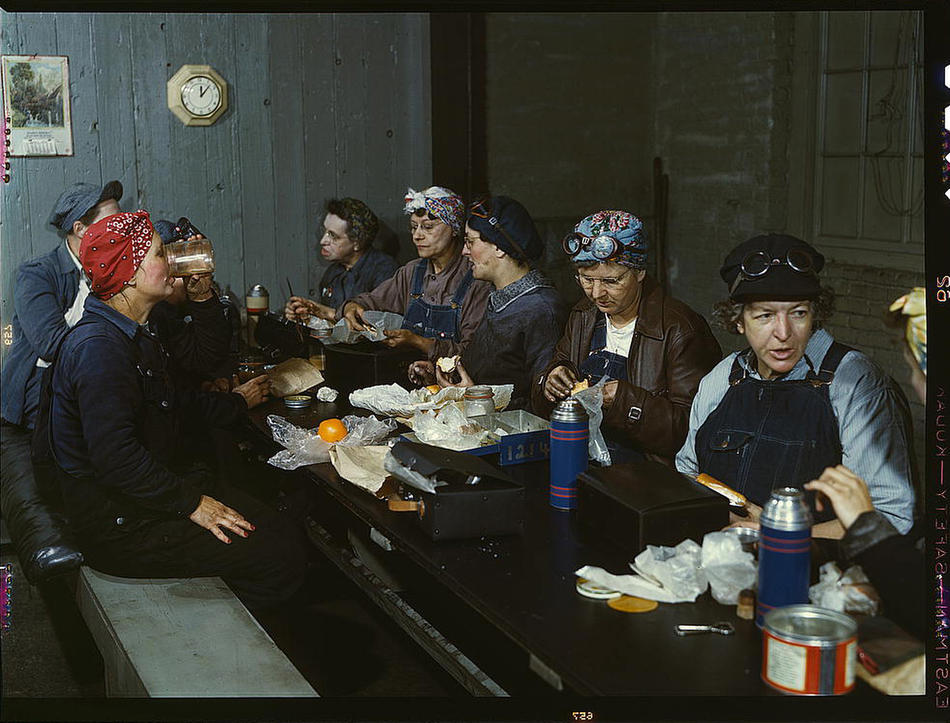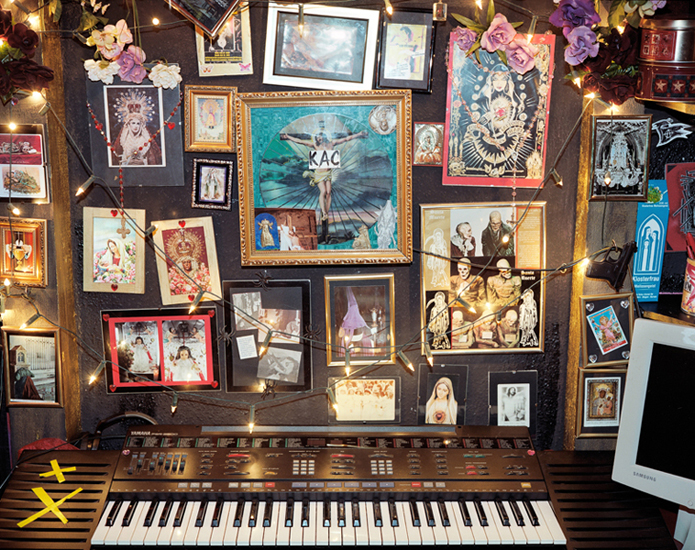Time Lapse Still Life
bay area blog events photography TPG10
A1 (Linard) from grahame weinbren on Vimeo.
Weinbren is doing a collaborative event at 01SJ in September
bay area blog events photography TPG10
A1 (Linard) from grahame weinbren on Vimeo.
Weinbren is doing a collaborative event at 01SJ in September
blog exhibits fashion photography reblog

Women workers employed as wipers in the roundhouse having lunch in their rest room, Chicago and Northwest Railway Company. Clinton, Iowa, April 1943. Reproduction from color slide. Photo by Jack Delano. Prints and Photographs Division, Library of Congress
Back in 2006, the Library of Congress organized an exhibition titled Bound for Glory: America in Color that showcased little-known color images taken by photographers of the Farm Security Administration/Office of War Information (FSA/OWI).
Made from color transparencies taken between 1939 and 1943, these images change the way we see the past. I mean, there’s just so much more color. As silly as that seems to say, it makes these photos intimate and relate-able in a way that I haven’t felt before. The black and white images of this era neutralize the bright colors and patterns in the clothing, signs, and wallpaper. It makes it seem like this time wasn’t so long ago.
The photographs depict the effects of the Depression on America’s rural and small town populations, the beginning of the nation’s subsequent economic recovery and industrial growth, and the country’s great mobilization for World War II.
According to Wikipedia, these slides would have been some of the first of their time, as the chronology of the development of color transparencies look like this:
YOU CAN VIEW THE PHOTOS EASILY HERE
there is a book of these images too.
blog fashion others lives photography
blog events exhibits photography tpg5
TPG #5 artist Davin Youngs shows a new collection of photos in Chicago in February. Davin’s photos are wonderfully romantic, tactile, and beautiful. Should be a good show.
Photographs signify participation. They are visual representations of the ways in which space and relationships are navigated and/or participated in. WE is artist Davin Young’s expression of desire for thorough, deep and unique participation in the world and with those around him. This participation can span from isolation to intimacy.
Created without special lenses or digital editing, these images were achieved by somewhat simple (or complicated?) participation. Davin was close enough to capture and removed enough to observe. They are meant to share unique moments, but also serve as an invitation for you to participate, too. The hope is that together WE can collectively observe, enjoy and create.
DETAILS:
February 5 – February 27 2010
Opening Reception: February 5 7-11pm
Fill in the Blank Gallery
5038 N. Lincoln Ave.
Chicago, IL 60625
773.878.1750
info@fillintheblankgallery.com
contemporary art criticism photography Still Life with Strawberries TPG10
“Tell me what you eat, and I will tell you what you are.” -Jean Anthelme Brillat-Savarin1
As an omnivore, the human body can survive and maintain its health on an astounding array of diets. Our ideas about the foods we eat, however, are cultural. Until only the past few generations, eating habits and food cultures were passed down the generations by the shared meal experiences of families and social groups. The industrial farming practices and global shipping routes developed in the 20th century upended these evolutionary relationships, supplanting the ideological roles of mother and tribe with supermarket capitalism. Not only do agribusinesses provide the diverse foods we eat, they provide their own cultural context, communicating new memes of taste, health, and culture. In a critique of the marketing of industrial organic foods, Michael Pollen unpacks such culinary signifiers in The Omnivores Dilemma:
“Taken as a whole, the story on offer in Whole Foods is a pastoral narrative in which farm animals live much as they did in the books we read as children, and our fruits and vegetables grow in well-composted soil … “Organic” on the label conjures up a rich narrative, even if it is the consumer who fills in most of the details, supplying the hero (American Family Farmer), the villain (Agribuisnessman), and the literary genre, which I’ve come to think of as Supermarket Pastoral. By now we may know better than to believe this too simple story, but not much better, and the grocery store poets do everything they can to encourage us in our willing suspension of disbelief.”2
This disconnect between our ideals of food production and its practical realities is bridged by visual language. As the narratives are consumed, they produce comfortable illusions about the substance of our food, providing a false culinary wholeness, like a gastronomic Potemkin village.
It is the cocoon of food packaging that envelops Stephanie Dean’s Modern Groceries series in contemporary consumer life. The photographs reenact Dutch still life master paintings from the fifteenth century, capturing the oblique soft light and deep shadows in saturated color. Objects are arranged with the same aesthetic fetish, displaying the bounties of the harvest and trade, as well as objects of curiosity, arranged perfectly askew over intricate linens and drapery. The produce, meats, and cheeses in the photographs are the same as their historical counterparts, but revealed to be modern industrial agricultural products by their packaging. Their presence subverts the bucolic ideals of the produce; the plastic is there to protect the food while it is transported globally and provides the surface where a plant can be re-branded into an emblem of the Supermarket Pastoral. The most visually subtle image in the series, “Still Life with Strawberries,” generates this subversion with only transparent plastics and a cluster of pricing stickers. An ironic disposable quality leaches from the packages, given their synthetic ecological permanence, in contrast to the finely crafted tableware and voluptuous produce.
By employing the visual archetype of the still life, Dean frames the work within the historical tropes of the Dutch master painting. The Dutch still life marked a shift in the visual content and economics of European painting in the fifteenth century. These canvases were commissioned by a rising merchant class, not the aristocracy or church, who had underwritten most previous art production. The merchant-traders sought depictions of what brought them power – goods produced by guilds or secured in trade – just as the aristocrats and popes commissioned works of religious, mythical or political authority that supported their ideological dominance. These paintings built a representative system that redefined the commercial products of the time into an ideal, much like the marketing techniques documented in contemporary grocery stores by Michael Pollan. Furthermore, the down-to-earth aesthetic of understated wealth on display in the paintings mirrors the criticisms of elitism and affluence frequently pointed at today’s progressive food movements such as Slow Food.
In this way, the Modern Groceries series can be seen as a critique not only of contemporary agricultural practices, but of the manipulative power of visual language. At the same time, the photographs delight in the pleasure of the food and the seductive beauty of nature and light. The images dwell in a cognitive disconnect of the sensory and the political – a feeling that many of us experience every week, as we push our carts down the aisles of our favorite grocery markets.
1 Jean Anthelme Brillat-Savarin, The Physiology of Taste, 1825
2 Michael Pollan, The Omnivore’s Dilemma: A Natural History of Four Meals (New York, USA: Penguin Group (USA) Inc., 2006), 137.
Brian Andrews is an artist who works with photography, video, and emerging media. Not content to just make things, he records as the west coast producer for Bad at Sports Contemporary Art Podcast. His critical writings can be found on Artnet and in Beautiful/Decay Magazine, as well as in numerous catalogs. Currently, he is the Course Director for the compositing program in animation and visual effects at Expression College for Digital Art in Emeryville, California.
artist interviews Artist Interviews blog photography Still Life with Strawberries TPG10
Stephanie Dean was interviewed via Skype on May 13th, 2009 by Oliver Wise and Eleanor Hanson Wise of The Present Group.
Listen:
blog photography Still Life with Strawberries TPG10
Still Life with Strawberries is an edition of 50 archival photographs on Hannemuhle 308 measuring 9.5″x14″.
Stephanie on the Modern Groceries Series:
I am creating a series of still life photographs focusing on the way our purchased food is packaged and consumed. By setting common foods in their packaging and labeling direct from the grocery store into traditional nature mort compositions, our most common and necessary items of life – food – are jolted into historical focus. The viewers’ various degrees of knowledge of Dutch still life paintings will be the measure by which the photographs will either found or further the perceived rift between ourselves and nature, and ourselves and our food sources.
Bio:
Stephanie Dean attended the California College of Arts (San Francisco & Oakland, CA) where she received her Bachelor’s of Fine Arts in Photography. In 2005 she earned her Masters of Fine Arts in Photography from Columbia College, Chicago. Her photographic thesis was the body of work “?Boys/Men?” asking the question of when do modern boys become men. Her written thesis was on existentialism in Robert Frank’s The Americans. She has taught at Columbia College Chicago and is currently teaching the History of Photography at Oakton Community College in Skokie & Des Plaines Illinois.
blog blogs others lives photography

It’s always fun to check out the homes of creative people. Here’s a mother lode from all over the world.
artist interviews blog blogs internet neat projects photography
From the people of We Can’t Paint: Wassenaar

photo: Andrés MarroquÃn Winkelmann
From the Editor’s Letter about Wassenaar:
“Wassenaar is an Internet specific publication that focuses its curatorial eye on emerging photographers, photography books from established, independent, and self-publishers, as well as interviews conducted by bloggers. This simple formula, while structured much like a magazine, takes the ethos and subjective freedom of blogging by existing as both absent of commercial interests and free from a specific template. The ability to take risks in an online space means that the following issues of Wassenaar may only focus on a specific artist, type of photography, a single book, or even simply feature a collection of artist portfolios. In short, Wassenaar aims to be an online magazine that reflects its place within the web as an entity that continually evolves, never forgetting that this form publishing is indefinable.”
Lego Hello World
I wish all my printers were made of legos.
LIFE photo archive hosted by Google
Images from Life Magazine going back to 1860′s, hosted by Google
Coming Face To Face With The President
Well crafted story about an under-heard point of view.
In California, Pot Is Now an Art Patron
A new funding source for the arts – reaping big rewards and funding many projects. It’s pot.
Notes on Portraiture in the Facebook Age
Celebrity Book Club: A List to End All Lists
Because, well, it’s sortof awesome.
Are "Artists' Statements" Really Necessary?
The pros and cons about that nemesis for most artists.
This to That
You tell it what you’ve got and it’ll tell you what to glue them together with.
Work of art: Online store for buyers, sellers
Not the TV show! Kelly Lynn Jones from Little Paper Planes is interviewed on her project, gives us a cheat sheet to local affordable art resources.